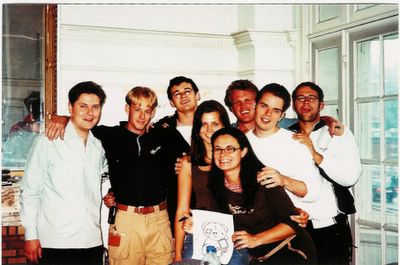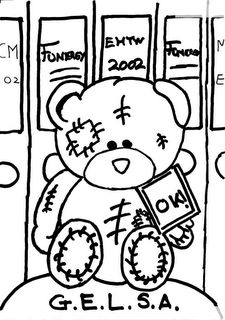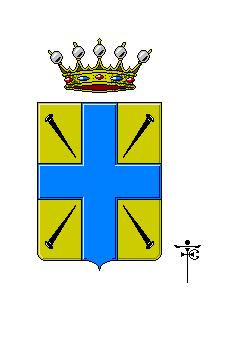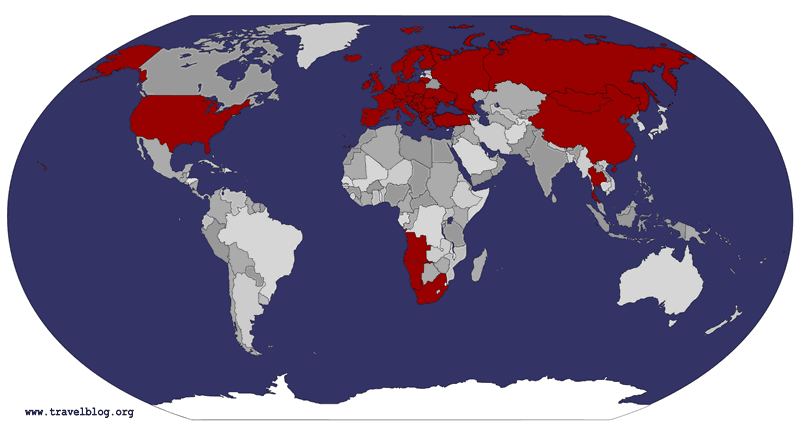Friday 25 February 2005
My Dutch blog in French
Just checked who all visited my blog and ran into this link:
http://216.109.124.98/language/translatedPage?tt=url&text=http%3a//eisenreich.blogspot.com/&lp=nl_fr&.intl=fr&fr=fp-tab-web-t-1
Someone translated my blog in French! Wonder who that was.
Posted by
Eisenreich
at
2/25/2005 03:46:00 am
0
comments
![]()
The old gentleman with the scythe
Posted by
Eisenreich
at
2/25/2005 03:24:00 am
0
comments
![]()
Wednesday 23 February 2005
Lazy & Boring
On the other side: read the message before and you can see that not really anything shocking or special happens in my life. I didn't meet nice people in the train, didn't have a nice chat at the busstop, didn't flirt with the lady behind the counter in the foodstore and didn't see something special or worthmentioning happen. Can I say now that my life is boring?
Posted by
Eisenreich
at
2/23/2005 01:00:00 am
0
comments
![]()
About me
About that: well I planned to finish this summer, but since I am taking a short BA in International Organisations, they refuse to let me do my main course which I need to write my thesis and to finish. Ok, I have finished my thesis already, but since I can't take the course, I can't hand it in... Real bummer, as I really want to finish and I'm not getting any younger... Due to all those classes I can hardly work, besides the obligatory hockey trainings I am giving 4 evenings a week. Not that there is much to drive (as I'm still a private driver), but ok, am sometimes missing those hours. Therefore my financial situation is (although: more as usual) below average and have to cut again on food. :) So please donate to the known bankaccount.
So what am I doing besides hockey, uni and writing stupid messages on this blog? Euh, not much. The happy life as it was during my first years of study is over. No more reviewing games and movies as one of the first in NL, no more hours/days of computer gaming, no more very short term trips to friends and wherever, no more dating every girl I can get (euh: did I ever?), no more making more than €1200 (netto) a month and spending it all... The good old days...
So what are my plans till the summer? Well, Kate (former ELSA IB-member) is getting married and I am invited to come, but it's in Georgia. Christina wants to become an IB-member and will hopefully get elected in Vilnius. There are elections in Albania and I want to be an EU observer there and finally I planned a trip with 2 friends of mine to Madrid. As you can see: all trips and no money. Isn't that a lovely combination? Well, will see what will happen and what not. Does anyone have some nice holiday tips for the summer? :)
Posted by
Eisenreich
at
2/23/2005 12:45:00 am
0
comments
![]()
Saturday 19 February 2005
Musictips 18
Paul Oakenfold - This Is Trance
Coldplay - Amsterdam
Snow Patrol - Chocolate
Patrick Bruel - J'te mentirais
Featured Artist of the Week: Katie Meluha
Posted by
Eisenreich
at
2/19/2005 07:44:00 pm
0
comments
![]()
Sunday 13 February 2005
Tuesday 1 February 2005
Some Albanian Nostalgy
THE first word a visitor to Albania is likely to learn is "lavazh."
It means "car wash."
And in the ride from Mother Teresa International Airport outside Tirana to the heart of the city, about 15 miles, every tourist will see it several dozen times, handpainted in front of a home or professionally done in front of a solid business.
In fact, car washes appear to be the signature business of Albania, which is surprising for a Maryland-sized country where private automobiles were banned until 1991. But it's not much more surprising than the fact that, here in what is by far the poorest country in Europe, at least 90 percent of the cars are Mercedes-Benzes. (Almost no one contests that many have been stolen in Germany, smuggled into Albania and then sold by mafia-connected gangs.)
What is not unexpected is the quality of the roads on which all these Mercedeses travel. In urban areas they are fine, and there are rural stretches that are all right too. But in the mountains - and the bulk of Albania is mountainous - the roads are something else: twisting, barely two-lane ribbons of asphalt perched above ravines or the sea without any barrier whatsoever. Numerous crosses and shrines along the roadside testify that accidents occur.
Yet in Albania even the expected carries with it something more. The heart-stopping roads open up spectacular mountain scenery and historic sites in the interior, and along the coast they offer views to shame those of the Amalfi Drive and give access to beaches that rival the Adriatic's best.
Friends had been mystified by my decision to sign up for a two-week package tour of Albania with the British company Explore. Their image was of a poverty-ridden backwater barely in the 20th century, much less the 21st, and recent history held out little to change their minds. Widespread rioting preceded the first post-Communist elections, in 1992, and the ballot box did not come close to resolving the country's problems. In 1997, the collapse of a giant Ponzi scheme led to a nationwide upheaval in which rioters destroyed factories, army barracks, hotels and scores of other buildings.
But stability has returned and, with it, an economic bustle, though the foundation of that is suspect. Few of the old factories have been rebuilt, and there is minimal evidence of new ones. The scores of money changers on corners point to the importance of remittances sent by Albanians working abroad. Home construction is booming, but hundreds of unfinished houses dot the countryside. Cellphones are ubiquitous, although much of the retail commerce remains in the pre-Bell-system era.
This contemporary blend, laid on top of a rich history and natural beauty, makes Albania a compelling destination, as long as one can tolerate occasional frustration, meal after meal of average Italian food, spartan hotels and, yes, those roads. The rewards proved so great that even after covering more than 500 miles of the country by bus, no one among the 18 members of the tour felt that we had stayed too long. The Albanians were invariably cordial, when they took any notice of us at all, and as the Bushi Bar (complete with the United States presidential seal on the sign) attests in Tirana, the capital, Americans are welcome.
Greek colonists and their Roman successors left the first imprints on Albania, and the ruins of two of their cities, Apollonia and Butrint, remain to entice visitors. Butrint, just across the strait from Corfu, is a World Heritage site and should soon join the likes of Delphi on the ancient-cities tourist circuit. It has a handsome theater, a Lion's Gate that rivals Mycenae's and a Temple of Asklepios where healing water was dispensed. It was also an early center of Christianity. The size of its basilica illustrates that, as does an impressive circular baptistry from the sixth century. On the acropolis above the 40 or so acres of ruins - there is no modern town on the site - is an early 19th-century fortress, which offers fine views of the ancient city and Corfu.
After Butrint, most historical attractions that we saw fit easily into two categories: richly decorated houses of worship (mosques or remote Greek Orthodox churches) or fortresses. The former are, without question, the glories of the country and are accessible to members of all faiths; the trick is getting through the door. The early 19th-century Mosque of Ethem Bey, on Tirana's main square, is the rare case of easy access. For the rest, one must find the keeper of the key, and to do that, a local guide or a working knowledge of Albanian is essential. Even then, the odds are daunting. Assuming that one can learn where the custodian lives, it is unlikely that he is just sitting at home waiting for tourists.
But oh, are there rewards for perseverance and luck. The Church of St. Nicholas in the isolated mountain village of Voskopoja, in eastern Albania is a treasure of early 18th-century frescoes. Portraits of saints, emperors and warriors and scenes from the Bible fill every foot of the interior and the outside porch. In the Church of St. Mary, in the hillside hamlet of Lipe, a 30-minute walk above Permet in the south, frescoes also vividly depict the hellish fates of sinners, like having their tongues pulled out by tongs or being roasted alive on a spit.
At least two of the country's mosques (roughly 70 percent of the country's 3.5 million people are Muslim, 20 percent Albanian Orthodox and 10 percent Roman Catholic) rival their Christian counterparts in elaborate decoration: the Mosque of Ethem Bey in Tirana and the Mosque of the Bachelors in Berat, both completed in 1827. Their porches and interiors are a riot of painted flowers, fruits, leaves, swirls and arabesques, mostly in reds, yellows and greens, punctuated by idyllic scenes of cityscapes. The effect is dizzying.
The country's fortresses are a starker breed. Some, like the great citadel of Berat, were begun in Byzantine times and eventually encompassed a small city; others, like the compact fortress on the Bay of Porto Palermo, date from the early 19th century. At least one, on the acropolis of Gjirokaster, was in use as late as the 1930's as a prison; it is now a museum that includes a reputed American spy plane downed in the 1950's and a robust collection of weaponry.
Of the fortresses, the one in Berat, in central Albania, merits the most attention. Much of the interior has been cleared, but people still live within its walls, and it should be easy to find someone to open at least one of the citadel's handsome Orthodox churches. Parapets offer spectacular views of the city and the Osum River valley. But the place not to miss within the walls is the Onufre Museum, Albania's finest collection of icons, inside the 18th-century Cathedral of St. Mary. The highlights among the dozens of icons are the brilliantly colored works of Onufre, a 16th-century Albanian who departed from the static traditions of Byzantine iconography to invest his subjects with personality.
Albania is rich in museums. Every medium-sized town, it seems, has turned a former home into an ethnographic museum. The one in Gjirokaster, for example, is in the house where the future Communist dictator Enver Hoxha was born and grew up and still has a few Hoxha family items. The one in Kruje, while relatively small, is particularly rich in details of Albanian urban life in the 19th and early 20th centuries.
Two museums, the National Historical Museum, in Tirana, and the Skanderbeg Museum, in Kruje, are indispensable to understanding the country.
The Tirana museum documents Albania's history from prehistoric times through the Hoxha era, which began in 1944 and ended with his death in 1985. Labels are only in Albanian, but that is little handicap to appreciating the array of items through the Ottoman era, like flint tools, cult figures, jewelry and mosaics. The rooms devoted to the quest for independence, on the other hand, are meaningless without a guide.
The exhibition dedicated to the victims of Communism transcends the need for any literal explanation. Walls of one room bear nothing but rows of names. In the adjoining room glass cases hold the most personal of effects, like a shirt, a pair of eyeglasses, a set of dominoes. On either side of a barbed-wire "wall" hang dozens of photographs of individuals standing at a microphone. In the center is a concrete cell, about 10 feet by 8, inside which are a handful of personal items and two chains attached to a bloodstained wall. Depressing as the exhibit is, it reflects the Hoxha era, whose impact is still felt - and seen - daily.
But it is not Hoxha that the Albanians want their visitors to remember. It is Skanderbeg, the national hero who kept the Ottoman Turks at bay from 1443 to 1468, and the Skanderbeg Museum is their billboard. Built in 1982, the monstrous structure sits on a crag beside the ruins of his castle. My guide seemed aware that to Westerners the museum's presentation might appear overdone when he pointedly said that the accounts were all from Western sources, not Albanian ones.
In any interpretation, the story of Skanderbeg's battles is riveting, and the museum, whose exhibits are labeled in English as well, does an excellent job. What is most interesting for a Westerner, however, is the museum's spin: By derailing the Turks' western advance at the height of their power, it contends, Skanderbeg saved most of Europe for Christianity. The West, then, owes what it is today to Albania.
And the West is what Albania now eagerly embraces. There are all those Mercedeses. Western beers are preferred over Tirana Pils (even though the latter is delicious and cheaper). Italian food is more available than native Albanian dishes. The country's splendid beaches are used mostly by local people, but the southern resort of Sarande is being grossly overbuilt to accommodate a hoped-for flood of foreigners.
Sarande is but one example of the changes that tourism, and the desire for more of it, is bringing. Tirana now has a Sheraton, Durres an impressive new archaeological museum. A brand new two-lane highway has replaced part of the hair-raising coast road between Sarande and Vlore; a midsized hotel is going up inside Llogara National Park.
And everywhere entrepreneurs are seeing opportunities. Hoxha had some 700,000 concrete mushroom-shaped bunkers built all over the country to fend off prospective invasions. They are still there, a signature of Albania for tourists, and someone has begun mass-producing miniatures, in alabaster, as souvenirs. A bargain, at $4.25.
Posted by
Eisenreich
at
2/01/2005 01:30:00 pm
0
comments
![]()


















